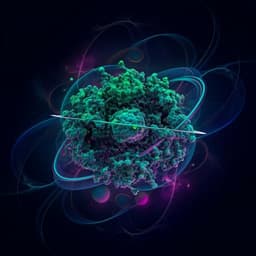
Physics
Controlled single-electron transfer enables time-resolved excited-state spectroscopy of individual molecules
L. Sellies, J. Eckrich, et al.
Explore a groundbreaking single-molecule spectroscopy method developed by Lisanne Sellies, Jakob Eckrich, Leo Gross, Andrea Donarini, and Jascha Repp, which allows for detailed probing of quantum transitions within a single molecule. This innovative technique provides significant insights into molecular luminescence and chemical reactions.
~3 min • Beginner • English
Introduction
The study integrates scanning-probe microscopy with spectroscopic techniques to probe electronic properties of individual molecules at atomic resolution, including structure determination, orbital imaging, ESR, Raman, and luminescence. However, unambiguous assignment of observed signals to specific electronic transitions remains challenging. In STM-induced luminescence, signals have been controversially assigned (for example, phosphorescence vs. trion-related fluorescence in PTCDA). In STS, differentiating higher-lying excitations from multiple charging is difficult, as tip-to-molecule tunnelling is quickly followed by molecule-to-substrate tunnelling without separate detection, obscuring transient charge states. Even combining luminescence with tunnelling typically conflates multiple transitions into a single spectral feature. Thick insulating films can isolate molecules from the substrate, allowing control and detection of single-electron transfer between tip and molecule, granting access to various charge states. Building on this, the paper proposes a single-molecule spectroscopy that individually probes radiative, non-radiative, and redox transitions by controlled charge exchange between an AFM tip and a molecule. Spin states are mapped onto charge states and read out by electrostatic force detection. The central goal is to map the relative energies of low-lying ground and excited states in individual molecules and prepare defined excited states, demonstrated on pentacene and applied to clarify the controversial STML interpretation in PTCDA.
Literature Review
Prior single-molecule studies using scanning probes have enabled atomic-scale insights into molecular structure and orbitals, and integration with optical spectroscopies (Raman and luminescence) has advanced understanding of light–matter interactions at the single-molecule level. Nonetheless, literature reports contradictory assignments for STM-induced luminescence in PTCDA (phosphorescence T1→S0 vs. anionic fluorescence D1→D0), and STS often cannot unambiguously separate excited states from multiple charging effects. Thick insulating films have been used to electrically isolate molecules, enabling controlled single-electron tunnelling and access to multiple charge states, but comprehensive mapping of an individual molecule’s excitation spectrum has remained out of reach. The present work addresses this gap by combining controlled charge exchange with AFM-based charge-state read-out to disentangle and map individual transitions.
Methodology
- Samples: Pentacene and PTCDA on >20 monolayers NaCl grown on Ag(111), electrically isolating molecules from the substrate to prevent molecule–substrate tunnelling.
- Instrumentation: Home-built AFM with qPlus sensor (f0 ≈ 30 kHz, k ≈ 1.8 kN/m, Q ≈ 1.9×10^4) equipped with conductive Pt–Ir tip; operated under UHV (P < 1×10^−10 mbar) at 7–8 K in frequency-modulation mode (oscillation amplitude 1 Å).
- Tip preparation: Indentation into bare Ag(111) to form an Ag-terminated apex.
- Gate control: Voltage pulses (dc + ac) applied to the Ag(111) substrate act as gate voltage Vg; partial drop across NaCl with lever arm α shifts charged-state energies by qαVg, enabling controlled single-electron tunnelling between tip and molecule.
- Spectroscopy sequence (pump–probe pulses): Three phases per cycle:
1) Set pulse: Initialize molecule in a defined state (e.g., D0) by choosing Vset sufficiently beyond the S0→D0 relaxation energy and duration much longer than decay constant (e.g., 33.4 µs).
2) Sweep pulse: Apply Vsweep for a short duration τsweep (0.14–7 µs typical), enabling specific tunnelling transitions to populate a range of states depending on Vsweep.
3) Read-out: Apply Vread-out at the charge-degeneracy point (e.g., S0–D0 or S0–D0−). Due to strong electron–phonon coupling (Franck–Condon blockade), zero-phonon tunnelling between vibrational ground states is suppressed, stabilizing bistable charge states. Charge states are discriminated by AFM via electrostatic force (frequency shift) during a long read-out interval (e.g., 125 ms).
- Many-body description: States S0, S1, T1 (neutral), D0+/D0− (charged ground states), and D1+/D1− (charged excitations, trions) are considered. Gate voltage shifts energies between charge manifolds without altering intra-manifold spacings. Transitions are depicted in many-body energy diagrams with Gaussian-like Franck–Condon-weighted transition probabilities (offset by relaxation energies).
- Data acquisition and analysis: Pulse cycles repeated at ~8 Hz for ~80 s per Vsweep; charge-state populations obtained from frequency shift distributions; error bars from binomial statistics. Data fitted globally using differential rate equations encoding allowed transitions and tunnelling rates; multiple τsweep datasets jointly fitted per molecule. Lever arm α calibrated by referencing known S0–S1 energy of pentacene (2.26 eV) on NaCl/Ag; applied to convert voltages to energies. Reorganization energies and linewidths extracted from opposing-direction transition pairs.
- Spatial imaging: AC-STM images acquired at specific degeneracy conditions (HOMO/LUMO contrast) to identify orbital character and confirm tip position.
- Additional measurements: Triplet lifetimes for PTCDA measured via time-resolved population decay using varied repetition times; extrapolation to ultrathin NaCl (e.g., 3 ML) for comparison with STML involves accounting for screening, work function changes, lever arm differences, and substrate tunnelling.
Key Findings
- Established a pump–probe single-molecule spectroscopy that individually addresses radiative, non-radiative, and redox transitions by alternating single-electron attachment/detachment, with AFM-based charge-state read-out enabled by Franck–Condon blockade.
- Pentacene on >20 ML NaCl/Ag(111):
• Determined lever arm α = 0.70 ± 0.02 (≈30% voltage drop across NaCl), calibrated using S0–S1 = 2.26 eV.
• Extracted many-body energy differences (averaged over four molecules/tips): S0–T1 = 0.90 ± 0.06 eV; D0–D1 = 0.99 ± 0.04 eV.
• Reorganization energies for redox transitions (e.g., D0→S0, D0→T1, S0→D0) are all ≈0.9 eV with similar linewidths, supporting similar relaxation energies for paired transitions.
• Demonstrated preparation and read-out of defined excited states and assignment of sequential/cascade transitions via Vsweep thresholds and τsweep dependence.
- PTCDA on >20 ML NaCl/Ag(111):
• Extracted energy differences: S0–S1 = 2.39 ± 0.11 eV; S0–T1 = 1.28 ± 0.07 eV; D0–D1 = 1.34 ± 0.08 eV.
• Both T1→S0 (phosphorescence) and D1→D0 (anionic fluorescence) transitions match the 1.33 eV STM-induced luminescence photon energy reported on ultrathin films, indicating energy alone cannot distinguish the pathway.
• Triplet T1 lifetimes on thick NaCl: multi-exponential components ~350 ± 43 µs, 170 ± 13 µs, and 671 ± 62 µs (assigned to zero-field-split substates), much longer than charge-state lifetimes (~100 ps) on thin films, implying competition between phosphorescence and substrate-mediated tunnelling to D1 on ultrathin films.
- Provided many-body energy diagrams for pentacene and PTCDA and an extrapolated diagram for PTCDA on ultrathin NaCl, showing potential luminescence pathways and conditions for state cycling in STML.
- Method enables extraction of relative rates of competing transitions and preparation of molecules in defined excited states, with potential for spatial mapping of excited-state properties.
Discussion
The work addresses the longstanding challenge of unambiguously assigning single-molecule spectroscopic signals to specific quantum transitions. By decoupling molecules from the substrate with thick insulating films and controlling single-electron transfer via gated pulses, the method separates individual transitions that are often conflated in STM/STS and STML. Mapping of many-body levels and transition thresholds across charge states permits direct determination of key excitation energies (e.g., S0–T1, D0–D1) and reorganization energies, offering quantitative insight into spin and charge excitations at the single-molecule level. For PTCDA, the experimentally determined S0–T1 and D0–D1 energies being both consistent with the 1.33 eV STML line explains contradictory interpretations in the literature: both phosphorescence (T1→S0) and trion fluorescence (D1→D0) are energetically viable, and the dominant pathway is governed by competing rates (phosphorescence versus substrate-mediated tunnelling). The long triplet lifetimes on thick films versus short charge-state lifetimes on thin films highlight environment-dependent dynamics critical for interpreting STML. Overall, the method provides a robust framework to disentangle sequential and competing transitions, quantify excitation energies that are otherwise difficult to access (notably triplets), and inform the design and interpretation of tip-induced reactions and single-molecule light emission.
Conclusion
The introduced pump–probe spectroscopy based on controlled single-electron transfer and AFM charge-state read-out enables individual probing of radiative, non-radiative, and redox transitions in single molecules. It yields quantitative many-body level schemes, including ground and excited states for different charge manifolds, reorganization energies, and relative transition rates. Demonstrations on pentacene and PTCDA delivered precise S0–T1 and D0–D1 energies and clarified that both phosphorescence and trion fluorescence are viable origins of the debated 1.33 eV STML line in PTCDA. The method is broadly applicable, including to multiply charged states, provided a long-lived state is present, and can be extended to spatially map excited states and to prepare/control specific excited states to guide and engineer tip-induced chemical reactions and single-molecule luminescence.
Limitations
- Requires thick insulating films to suppress molecule–substrate tunnelling for separate control and detection of individual electron-transfer events; applicability to ultrathin films is indirect via extrapolation and subject to additional screening and work-function effects.
- Assumes similar relaxation energies for certain paired transitions when deriving energy differences; although supported by extracted reorganization energies and linewidths, residual differences may introduce uncertainty.
- The lever arm calibration relies on referencing to known transitions (e.g., pentacene S0–S1) and may be influenced by local environment, tip work function, and nearby features (e.g., step edges).
- Some modeling simplifications (e.g., neglecting small effects of cantilever oscillation on tunnelling rates) can cause minor deviations between fits and data.
- In PTCDA, the method cannot definitively distinguish phosphorescence versus trion fluorescence on ultrathin films by energy alone; pathway assignment depends on relative rates which may vary with film thickness and local environment.
Related Publications
Explore these studies to deepen your understanding of the subject.







